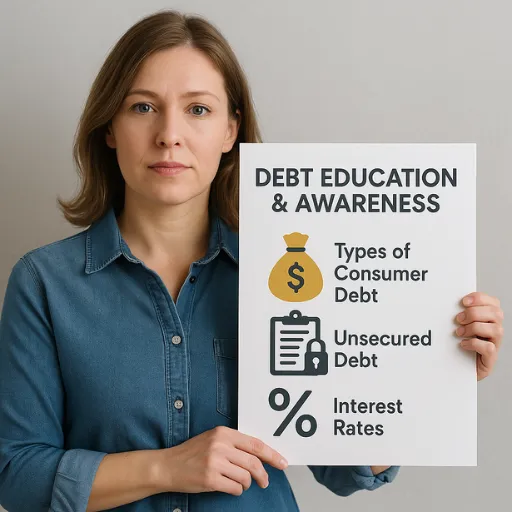
The 5 Most Common Types of Consumer Debt
Debt touches nearly every household in America, but not all debt is created equal. Understanding the different types of consumer debt is the first step toward taking control of your financial future. In this guide, we’ll break down the five most common forms of debt and how to start tackling them today.
Credit Card Debt
What it is:
Revolving debt that accrues interest when balances aren’t paid in full. Credit cards often carry some of the highest interest rates, ranging from 15% to 30%+ APR.
Why it’s dangerous:
Minimum payments barely chip away at the principal. If left unchecked, small balances can grow quickly.
How to tackle it:
Use the debt avalanche method: pay off the highest-interest cards first.
Consider a 0% balance transfer card (if your credit allows).
Explore debt relief options if you're overwhelmed with over $10,000 in credit card debt.
Auto Loans
What it is:
Secured loans used to finance vehicles. Payments are fixed, usually over 3–7 years.
Why it’s tricky:
Cars lose value rapidly. Many borrowers owe more than the car is worth called being “underwater.”
How to tackle it:
Refinance at a lower interest rate if your credit has improved.
Make extra principal payments to reduce interest over time.
Consider selling or trading in the car if it no longer fits your budget.
Student Loans
What it is:
Loans taken out to cover the cost of education. Includes both federal and private student loans.
Why it’s challenging:
Balances can be high, and interest can compound during deferment. Repayment options vary based on the lender.
How to tackle it:
Look into income-driven repayment (IDR) plans for federal loans.
Apply for public service loan forgiveness (PSLF) if you qualify.
For private loans, explore refinancing to lower your rate.
Mortgage Debt
What it is:
A long-term loan used to purchase a home. Mortgages are typically repaid over 15 to 30 years.
Why it’s normal, but important to manage:
This is often the largest debt people carry, but it's also backed by an appreciating asset.
How to tackle it:
Make one extra payment per year to reduce your loan term.
Refinance if you can lock in a lower rate.
Avoid taking out home equity loans for non-essential expenses.
Medical Debt
What it is:
Bills for medical care that are not covered by insurance, often sent to collections.
Why it’s harmful:
Many people are unaware of their rights—and unpaid medical debt can affect credit reports.
How to tackle it:
Ask for an itemized bill and dispute any errors.
Negotiate a payment plan or apply for financial hardship programs with the provider.
Use a debt relief program to consolidate or settle large balances.
Final Thoughts: Take Control of Your Debt
Debt may feel overwhelming, but you’re not alone and you do have options.
🎯 Tip: Start by identifying which type of debt is most urgent. Often, that means tackling high-interest credit card balances first.
If you’re carrying $10,000 or more in unsecured debt, you may qualify for a personalized relief plan. Click below to start your free debt review and explore your options, no obligation, just answers.
Ready to Take the First Step?
